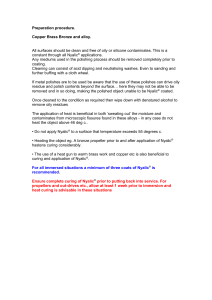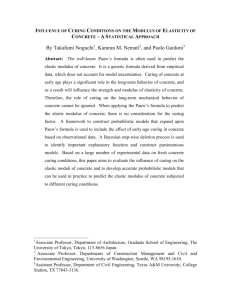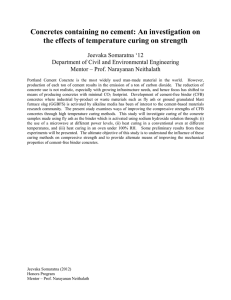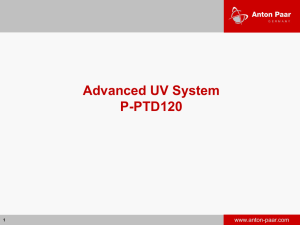Wet-Cast Curing Properties - National Precast Concrete Association
advertisement
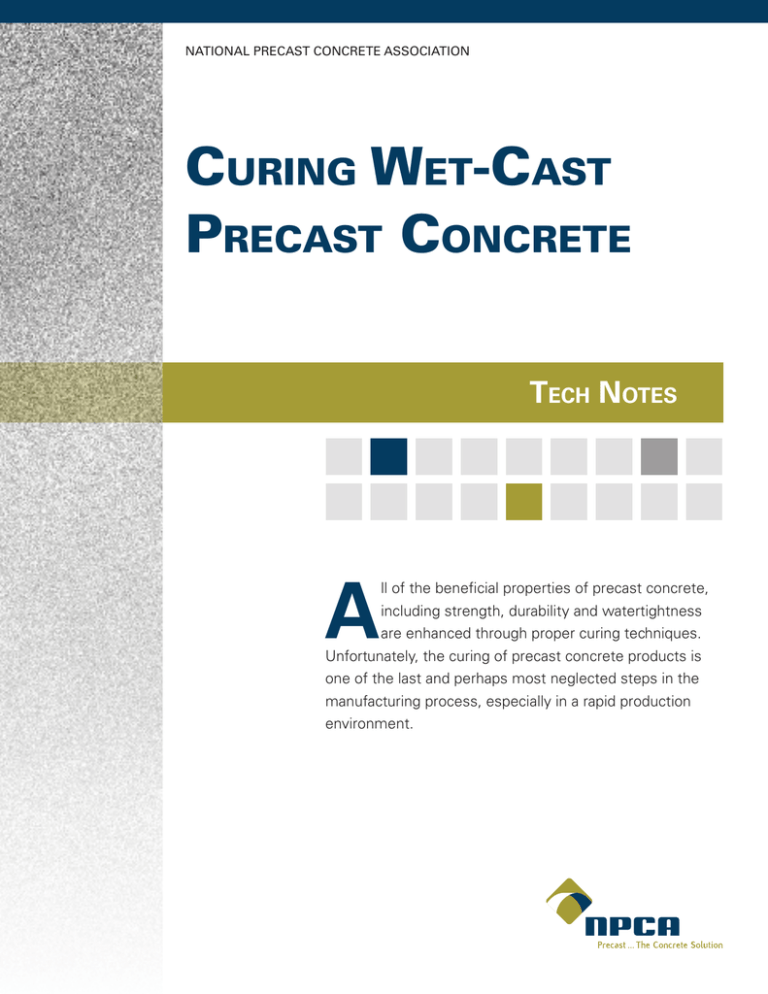
NATIONAL PRECAST CONCRETE ASSOCIATION Curing Wet-Cast Precast Concrete Tech Notes A ll of the beneficial properties of precast concrete, including strength, durability and watertightness are enhanced through proper curing techniques. Unfortunately, the curing of precast concrete products is one of the last and perhaps most neglected steps in the manufacturing process, especially in a rapid production environment. Greater attention to curing yields less permeable concrete (effect is more pronounced with higher w/c ratios High Strength Permeability Figure 1 Greater attention to curing yields stronger concrete Low Curing Curing Proper curing enhances impermeability and yields higher compressive strengths. To support aggressive production schedules, most • Monitoring and controlling the humidity to limit precast plants use greater cement content, admixtures moisture loss from the fresh concrete. The or other methods to accelerate normal curing times. In primary object of curing is to prevent or replenish addition, physical curing practices can also accelerate the loss of necessary moisture during the early, and enhance production by adhering to the two basic relatively rapid stage of hydration. precepts of proper curing: Ambient temperatures are perhaps of greatest • Maintaining adequate moisture during the critical importance. Higher temperatures accelerate the hydration process. As a rule of thumb, a temperature hydration period • Maintaining a favorable temperature to promote full hydration. The lower the temperature, the lower the rate of hydration. However, there is an upper limit on the curing temperature. increase of 18 F effectively doubles the hydration rate. However, an elevated temperature in a low humidity environment leads to the loss of needed water. A primary goal of curing is to keep the concrete Figure 1 illustrates the effect of curing practices on saturated. It is critical to provide the appropriate strength and permeability in wet-cast production. temperature and maintain a relative humidity of 80% in freshly placed concrete. Adequate curing is even Basic Principles more important when the water-cement ratio is Simply stated, proper curing entails creating the a moist environment. The prevention of water loss low, since there is insufficient free water to provide optimum environment to promote the hardening or hydration of freshly cast concrete. Hydration is helps ensure the strength of the concrete, leads to decreased permeability, less plastic shrinkage and the chemical process that ultimately binds cement avoids other undesirable factors. particles and aggregates into hardened concrete. During prolonged hydration, the cement in the mix Creating the optimum environment involves: develops into a gel, which reduces the size of the • Monitoring and controlling the temperature of the concrete and gradients (providing a favorable temperature [50 to 90 F] under conventional curing conditions and up to 140 F under lowpressure steam curing). 2 Tech Notes - Curing Wet-Cast Precast Concrete | precast.org concrete’s internal voids and greatly increases the watertightness of the concrete. For this reason, prolonged hydration through curing is a significant factor in attaining impermeable, watertight concrete. Keeping steel forms engaged for as long as possible Curing enclosures used to maintain temperature and moisture. can be an excellent means of protecting against loss of potential for self desiccation. This method is also not moisture. recommended for concretes containing pozzolans. Conventional curing and low-pressure steam curing are Polyethylene sheeting should be at least 4 milliliters two of the more common methods of curing precast thick and should be applied to the concrete as soon as concrete products. the concrete has hardened sufficiently. Sheets should be lapped (about 18 inches) and weighted, as needed. Conventional Curing All exposed surfaces, including exposed edges and Conventional curing involves the continuous saturation Curing compounds should be sprayed uniformly on of the concrete surface with water for a specified surfaces as soon as the water shine disappears but length of time, starting as soon as the concrete when the surface is still moist enough to ensure is no longer susceptible to damage at ambient adequate performance (1-3 hours after concrete temperatures. These conditions can be achieved by placement). Curing compounds should be stirred draping wet burlap or cotton mats, spraying, fogging or or agitated as needed before spraying. Curing membrane curing. compounds should be applied in two directions joints, must be protected against moisture evaporation. If spraying or fogging is done at intervals, the concrete must be prevented from drying between applications. When burlap or cotton mats are used, they should be kept moist. Alternate cycles of wetting and drying can cause surface crazing or cracking. For low watercement ratios wet curing is highly desirable. Membrane curing is another method of conventional curing using polyethylene sheeting, curing compounds or similar material. With membrane curing, external water is not used in the curing process. This method should be used with caution for products with watercement ratios less than 0.5, however, due to the 3 Tech Notes - Curing Wet-Cast Precast Concrete | precast.org (vertically and horizontally) to ensure full coverage and should not be thinned or otherwise modified. Curing compounds are available in clear and colored (white) formulations. Colored formulations are easier for verifying full coverage. Low-Pressure Steam Curing Low-pressure steam curing adds moisture and increases the temperature, which are important factors that accelerating the curing process. Both result in an increased rate of hydration. 175 Temperature (F) 140 Steaming Time Controlled Heating Controlled Cooling 105 70 Subsequent Curing or Storage Pre-steaming Period 35 24681012 Time (H) Figure 2: The wet-cast curing cycle. Low-pressure steam curing can be performed in concrete to the ambient temperature without an enclosed permanent structure or in a temporary causing distress. enclosure formed by a heavy tarp. 2.Start with concrete that is as warm as possible To achieve the best results when steam curing: 1. Apply elevated temperatures after the initial set of the fresh concrete. This is usually a period of 2 to 4 hours. 2.Apply a gradual temperature rise of not more than 40 F/hr, up to a maximum temperature between 120 F and 140 F. 3.Maintain a relative humidity between 75-90% 4.Gradually lower the temperature at a rate not to exceed 20 F per hour to avoid any thermal shock. Moisture evaporates very quickly from a hot surface and the durability to weathering and atmosphere will be detrimentally affected. and ensure that all plant equipment is warm at the start of concreting. Where hot water is used, it should be added and mixed into the aggregates. Cement should be added as the final ingredient. 3.When the concrete product has thin sections with openings, maximum temperatures may need to be decreased. Excessive temperature can result in excess loss of water. 4.Assess the applicability and performance of admixtures under accelerated curing conditions. Practices recommended under normal temperature curing may not be applicable. Too rapid an evaporation rate at low humidity Details on other accelerated curing methods can be will cause the surface to dry out and produce a found in ACI 517.2R, Accelerated Curing of Concrete at concrete structure that has a permeable, poorly Atmospheric Pressure. cured surface with relatively poor durability. 5.Continue moist curing after steaming, as needed. Other methods or techniques for accelerated curing: 1. Molds and form work should be left on as long Special Conditions Special precautions are needed when the temperature is either below 50 F or above 90 F. Hydration proceeds at a much slower rate when the concrete temperature as possible. When stripped, the concrete should is low. Temperatures below 50 F are considered be covered, preferably with wet burlap. The unfavorable. Ideally, precast concrete operations prime goal is to decrease the temperature of the should be performed in heated enclosures that will 4 Tech Notes - Curing Wet-Cast Precast Concrete | precast.org provide uniform heat to the products. In these cases, it is common practice to heat the mixing water and Conclusion even the aggregate if necessary. Water should not be heated above 140 F. Further recommendations on Curing, particularly within the first few hours after cold weather concreting are included in ACI 306, Cold concrete placement, is one of the most important Weather Concreting. factors in manufacturing top quality precast concrete Hydration rates are accelerated when the temperature products. Properly cured precast concrete will achieve is higher. When the ambient temperature is above 90 both superior early strength and long-term strength. F, the temperature of the concrete as mixed should Properly cured precast concrete products are also less be kept as low as possible by shading the aggregate permeable, more durable and display greater surface piles. Sprinkling aggregates with water will cool them hardness. by evaporation. In extreme cases, ice may be used in the mix water. In all cases, freshly cast products should be protected from the direct sunlight. Further recommendations on hot weather concreting are included in ACI 305, Hot Weather Concreting. References ACI 305R-10, Hot Weather Concreting ACI 306R-10, Cold Weather Concreting Gowripalan, N., et al “Effect of Curing on Durability,” ACI, Durable Concrete, 1994 Kosmatka, Steven H. and Panarese, William C. Design and Control of Concrete Mixtures, 15th edition, Portland Cement Association Mindess, Sidney and Young, Francis T., Concrete, Prentice Hall, Englewood Cliffs, N.J. 1981 Neville, A.M., Properties of Concrete 4th edition, Wiley & Sons, New York, 1996 This publication is designed to provide accurate and authoritative information, however the National Precast Concrete Association does not guarantee the validity or accuracy of any data, claim or opinion appearing in this publication. If engineering, legal or other professional services are required, the services of a competent professional should be obtained. The National Precast Concrete Association does not assume and hereby disclaims liability to any person for any loss or damage caused by errors or omissions in this publication, regardless of whether such errors result from negligence, accident or any other cause whatsoever. 5 Tech Notes - Curing Wet-Cast Precast Concrete | precast.org April 2013
